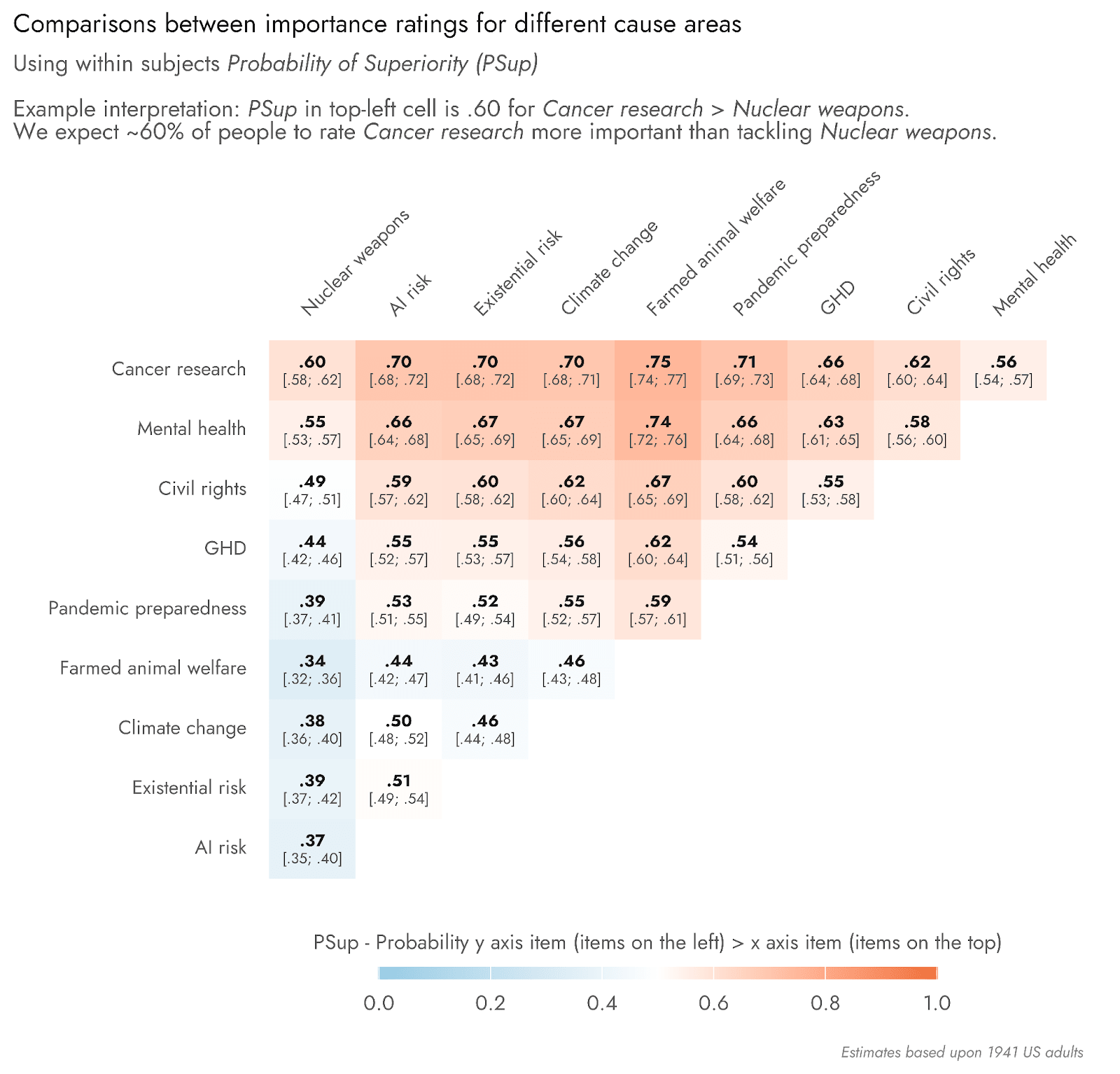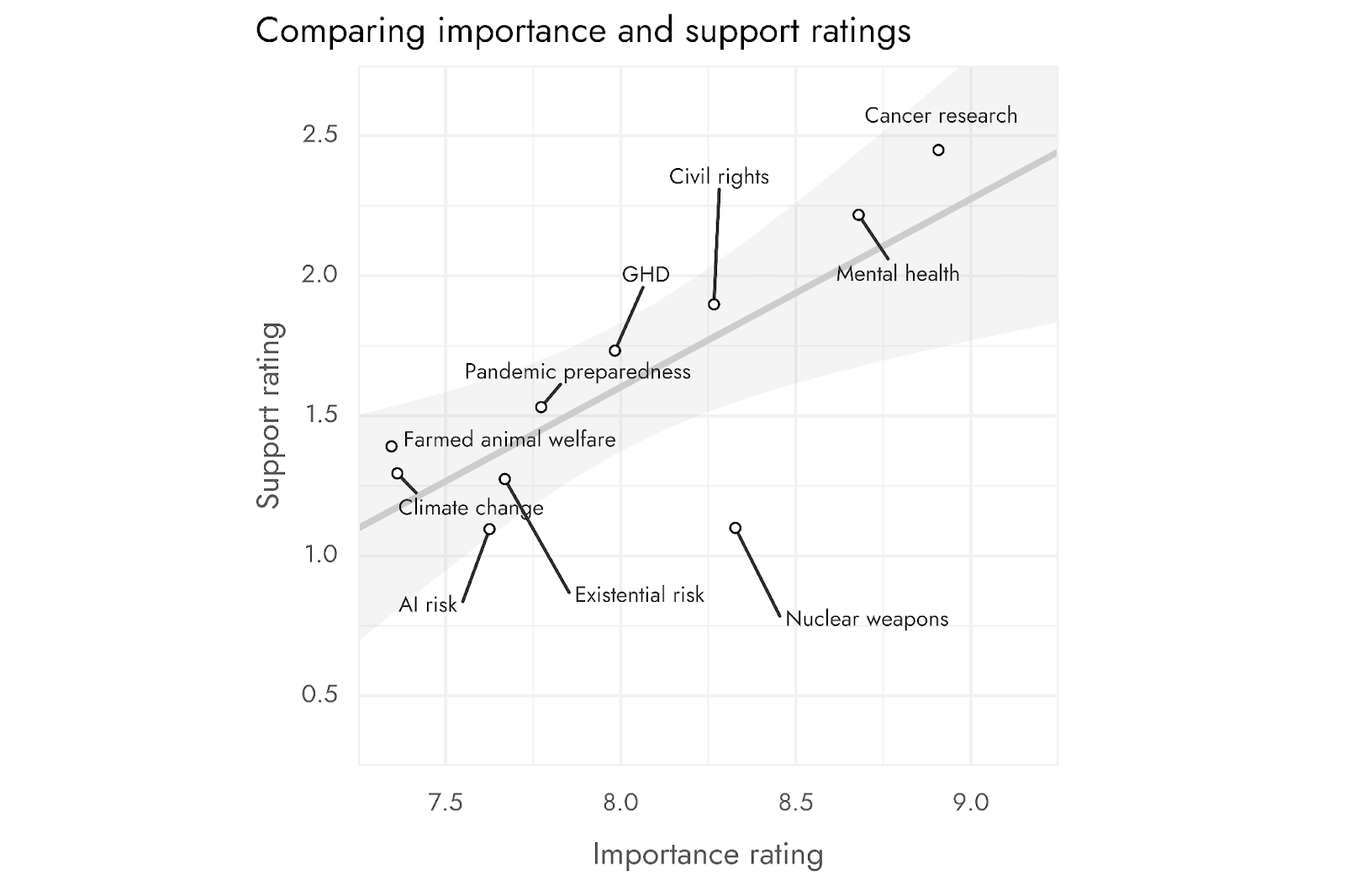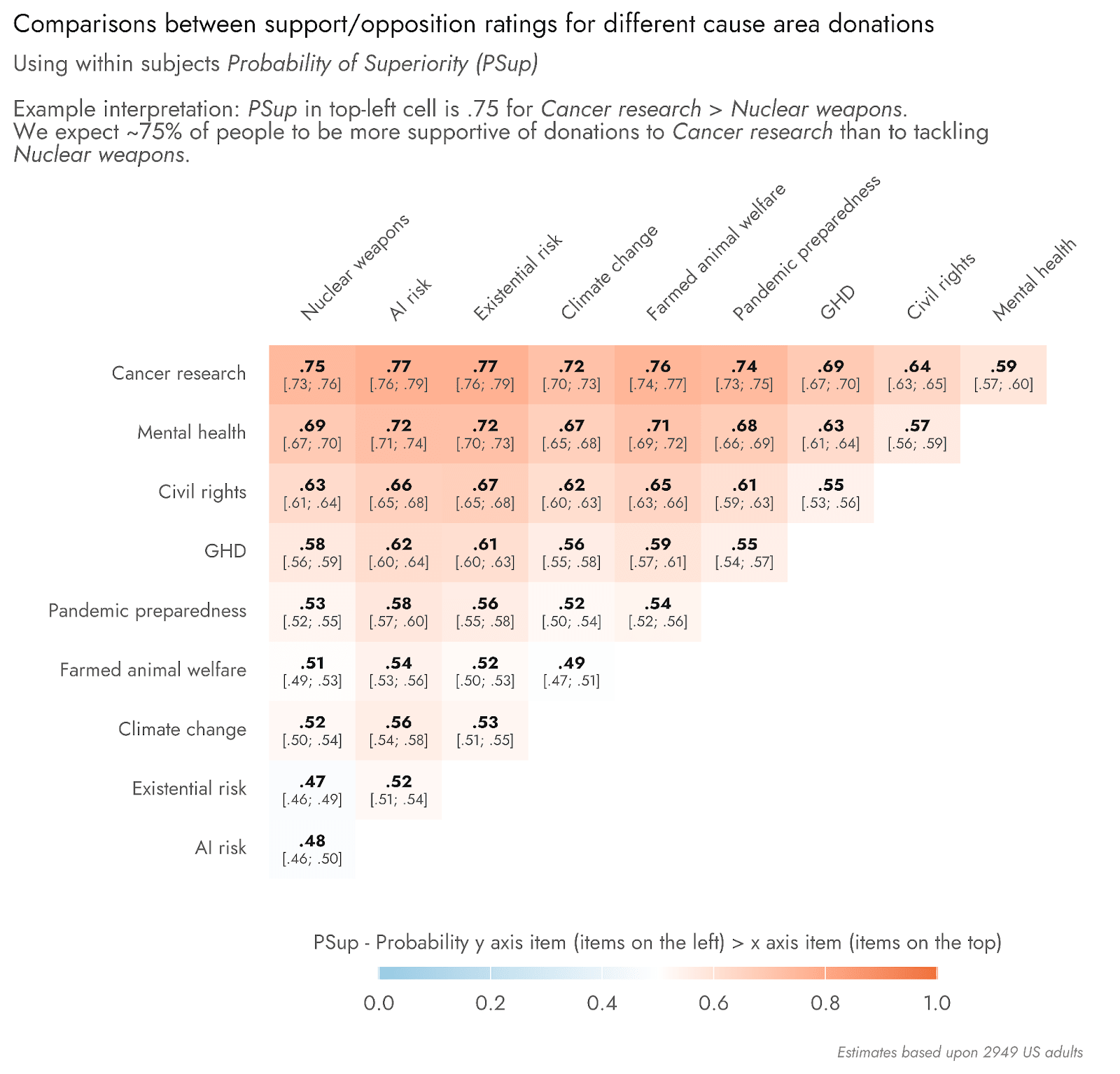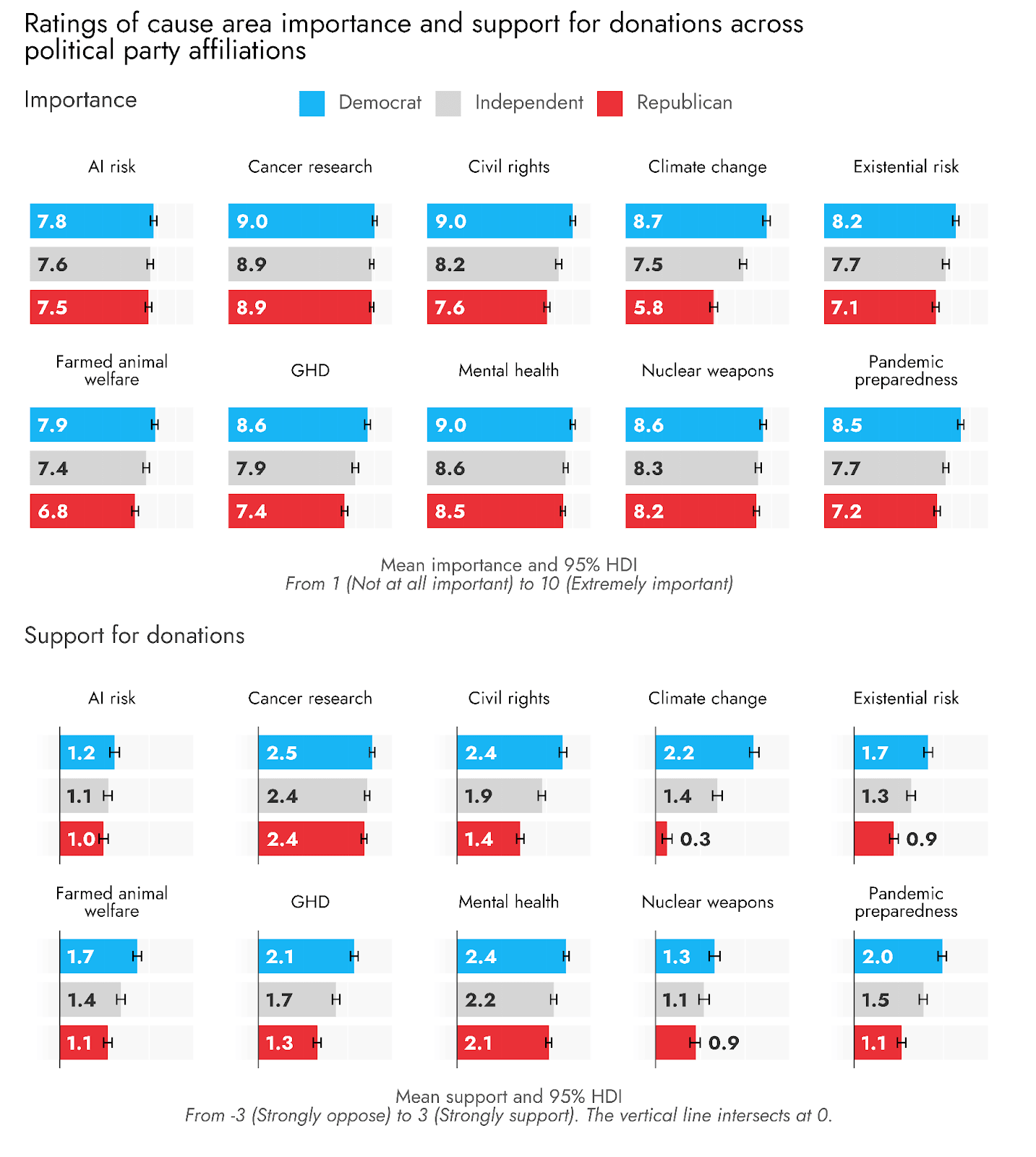Key takeaways:
- Traditional causes such as cancer research and mental health were rated as more important and received more support for donations than several causes often advocated for in EA - such as Animal welfare, Pandemic preparedness, and AI or Existential risk.
- Global health and development tended to be rated more highly than causes such as Existential risk or AI risk, but less important than Cancer research or Mental health.
- Although Global health and development was rated more highly than most other core EA cause areas, we still estimate around 69% of US adults would be more supportive of donating to fight cancer than to improve global health/poverty.
- Nuclear weapons stood out as receiving very high importance ratings, but relatively low support for donations. People may doubt or not be aware of viable opportunities for donating to reduce nuclear risk.
- There is significant scope for increasing the US public’s positive perception of several core EA cause areas, which still lag behind more traditional charitable causes.
The results presented here are based upon the responses of 4,890 US adults[1], who completed the Pulse survey between July and September 2024. The full report can be accessed on our website or as a PDF, which includes more detailed methodological and background information.
Attitudes towards major cause areas
Alongside interest in whether people are aware of specific Effective Altruism and related terms, people, and organizations (see here), it is crucial to understand the extent to which the general public engages with various cause areas focused on by impact-focused organizations. To do this, we split respondents such that 60% were asked the extent to which they supported or opposed people giving charitable donations to a range of cause areas, and 40% were asked how important they thought each cause area was. This split was done because the perceived importance of an issue does not necessarily correspond exactly to the extent to which people support it as a charitable cause area.
Each cause came with a brief description or example (the full text of all questions is available here). While this explanatory information aimed to be simple, informative, and uncontroversial, it should be noted that different framings of cause areas could lead to substantially different prioritization ratings (see, for example, our cause area framing report).
Cause area importance
Respondents who were randomized to see the importance items were told:
“Governments, charities, philanthropists, companies, and individuals all make choices about the most important issues of our time.
We would like to know what you think are the most important issues to be tackled in the world.
On the following pages, we will show you several different issues or 'cause areas'. Please rate how important you think each one is.”
The highest two rated causes in terms of importance were both individual ailments - cancer and mental health issues. Readers may be surprised to see Climate Change so far down the list, but this owes to political polarization surrounding the issue: respondents who were Democrats gave Climate Change an average rating of 8.7, whereas Republicans gave it an average of 5.8. In contrast, Republicans, Democrats, and Independents rated cancer research 8.9-9.0.
Global Health and Development ranked among the middle of the cause areas, whereas several cause areas that have become a focus of organizations related to effective giving - namely Pandemic preparedness, Existential Risk, AI risk, and Farmed Animal Welfare - fell in the bottom half of importance ratings. Still, essentially all causes were rated much closer to being ‘extremely important’ than ‘not at all important’.
Besides looking at means and ordinal rankings of causes, it is possible to compare ratings across cause areas more directly, using an estimate of within subjects Probability of Superiority. These values estimate the approximate likelihood that a US adult would rate one cause as higher than another, with values of .5 indicating no difference (i.e., 50% chance cause A is greater, 50% chance cause B is greater). Values below .5 indicate cause A being rated lower than cause B, and values over .5 indicate cause A being rated higher than cause B. The possible range of values is from 0 to 1 (0 = no one is expected to rate cause A > B; 1 = everyone is expected to rate cause A > B). Based on these estimates, we would expect around 75% of US adults to rate Cancer Research and Mental Health as more important than Farmed Animal Welfare.
Support for donations to cause areas
Respondents who were randomized to see the donation support/opposition items were told:
“On the following pages you will see several 'cause areas' or issues.
We would like to know to what extent you support or oppose charitable donors giving money to each of them.”
Similarly to the rankings based on importance, Cancer Research and Mental Health came out on top. However, Farmed Animal Welfare fared relatively better in terms of its placement among the ratings, and Nuclear Weapons fared much worse.
When plotting ‘Importance’ and ‘Support’ ratings against one another, Nuclear Weapons was something of an outlier, receiving relatively low donation support in comparison to the perceived importance of dealing with this issue. People may, understandably, feel that there is little opportunity or likelihood of success in donations geared towards preventing nuclear proliferation or war, even while acknowledging the importance of the issue. For other items, there was a strong coupling between importance and support, in terms of average population ratings.
As with importance ratings, it is possible to look at Probability of Superiority among the support ratings. Whereas Farmed Animal Welfare was rated lower than every other item in terms of importance, in terms of support for donations, it was rated slightly higher than AI risk, and similarly to Climate Change or Nuclear Weapons.
For most causes, with both Importance and Support ratings, respondents who identified as Democrats tended to provide higher ratings than those who identified as Republicans, with Independents intermediate between them. The most sizable difference was for Climate Change, but other causes also showed quite substantial political variation, such as Pandemic Preparedness, Civil Rights, Farmed Animal Welfare, and Global Health and Development. AI Risk appeared to be more uniformly rated than many causes, looking more similar to Cancer Research than to more polarized issues such as Climate Change. Republicans have not been found to donate less or be less supportive of charity than Democrats, but do tend to favor donations to religious causes and especially local religious congregations (see here for an example of such research). Advocates of effective giving may benefit from considering how promotion of high impact causes can better align with values across the political spectrum.
Rethink Priorities is a think-and-do tank dedicated to informing decisions made by high-impact organizations and funders across various cause areas. We invite you to explore our research database and stay updated on new work by subscribing to our newsletter.
- ^
The exact sample size for each question may vary due to missing data or branching of the sample to see alternative questions.







